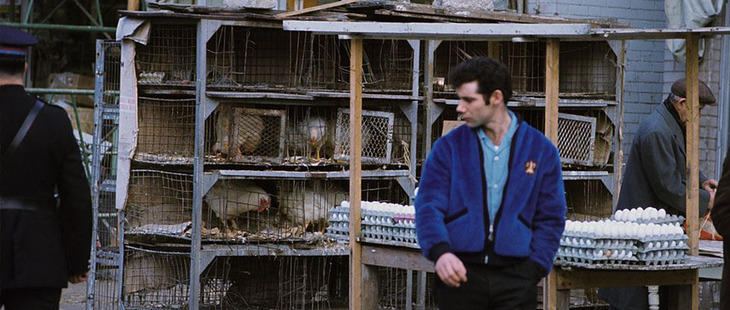
(City of Toronto Archives) This has all happened before, but somehow we forgot. On June 29, urban chicken farmers are either going to win a minor battle or lose a major one. The six members of the Licensing and Standards Committee may recommend city council amend the law banning backyard chicken coops. Or, they may not. Either way, they’ll be revisiting a debate that, yes, divided the city three decades ago. Until May 2, 1983, Toronto was, at least on paper, something of an urban agriculture utopia. If you wanted to keep a farm animal, that was fine. The city had a few bylaws regulating the days you could, say, move cattle to market or how many horses you could keep on a property, but if you were interested in keeping goats, pigs, chickens or rabbits that was fine and entirely above board. And for decades no one really seemed to mind. If you had a neighbour that kept a goat or a few chickens that was pretty much par for the course. In the 1970s, however, the city began to change. Municipal officials believed that the number of farm animals in the city was dramatically increasing. Their evidence was anecdotal but convincing: dog catchers were picking up marauding goats and pigs; complaints about crowing roosters increased; and more public health orders about animal waste were issued. After some time city officials noticed a pattern that correlated with changing demographics in the city. Arthur Allibone, then manager of operations for the humane society, told the Globe that most farm animal incidents were clustered in Toronto’s new “ethnic” areas. Here the word “ethnic” was code – code for Kensington Market and, in particular, its new Portuguese residents. City Hall had long had a fraught relationship with the neighbourhood. Unlike the Anglo-Saxon areas surrounding it, Kensington was perceived as gritty, dirty and smelly. To the chagrin of the fire department its streets were cramped and its dilapidated buildings a fire hazard; the health department hated the abattoirs that consistently thumbed their noses at city regulations; and the licensing board resented the merchants who sold their wares on public sidewalks. But, more than anything else, it was foreign and understood as much. In Protestant Toronto, Kensington had something of a European bustle and, perhaps more notably, it was the one of the few parts of downtown that didn’t submit to Anglo-Saxon mores. Where else could you buy a live chicken and have it killed and butchered right in front of you? Stacks of poultry cages, packed with live birds, lined the streets; vendors bartered and families went home with chickens strung over their shoulders. The smell was ghastly, the sidewalks were coated in chicken shit, but it had its own nostalgic old world charm and honesty (no sanitized food here). It became something of an attraction. But therein lay the rub. In the early ’80s a perfect storm conspired against Kensington’s (and by extension Toronto’s) chickens. As the Jewish community moved north and the Portuguese community moved in, the number of complaints about farm animals in backyards increased. Kensington was also becoming a destination for the middle-class (and the subject of flattering profiles in the daily newspapers). The new attention meant that embarrassing moments that once went unnoticed were given attention. For instance, in 1980, a man, claiming to be a modern witch-doctor, decapitated a chicken on College St. According to the Star, after draining its blood into a bowl he smeared it onto a concrete map of Canada. After denouncing confederation he smashed the map with a sledgehammer. The crowd of 70 or so was surprised, but the humane society was aghast. The timing could not have been worse. The society was just about to ask council to ban all farm animals from Toronto in order to shut down Kensington’s chicken trade. A few days earlier the society received two complaints from suburban Ontarians saying that they had witnessed cruel and inhumane treatment of poultry and its illegal slaughter. Meanwhile, health officials couldn’t believe that the food, so close to all of these chickens, in the area was safe to eat. The Kensington BIA launched a spirited defence. Merchants claimed that selling live birds (and goats for that matter) was a Kensington tradition. BIA president Gus Fisher implied contemptuously that the entire organization against them was the work of just one or two moralizing vegetarians. But when the Neighbourhoods Committee Chair Dorothy Thomas asked “How is wringing a chicken’s neck an expression of [the neighbourhood’s] cultural diversity?” it was clear that chickens stood no chance. The BIA won the support of just under half of city council (including two neophyte alderman, Jack Layton and Joe Pantalone) but proved unable to convince the remaining fence sitters. After much debate, live chickens – and all other farm animals – were banned from Toronto. It’s a story that should encourage today’s chicken farmers, but discourage the rest of us. The simple truth is that chickens were banned from Toronto because, in 1982, the respectability of chicken farmers was suspect. If thousand dollar, ultra hygienic chicken coops are proof of anything, this is no longer the case. Two decades ago the city fought over the vibrancy of street life and the right of a community to exist just outside convention; today we fight over whether foodies and the middle class, deservedly or not, should be allowed a chicken coop without risking a visit from the by-law enforcement officer. As usual: It’s first as tragedy, then as farce.














